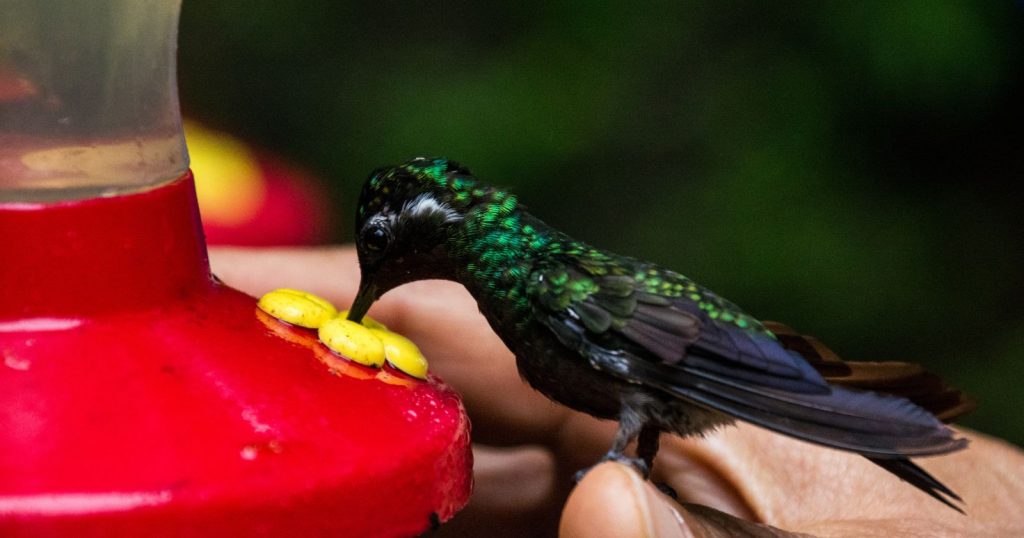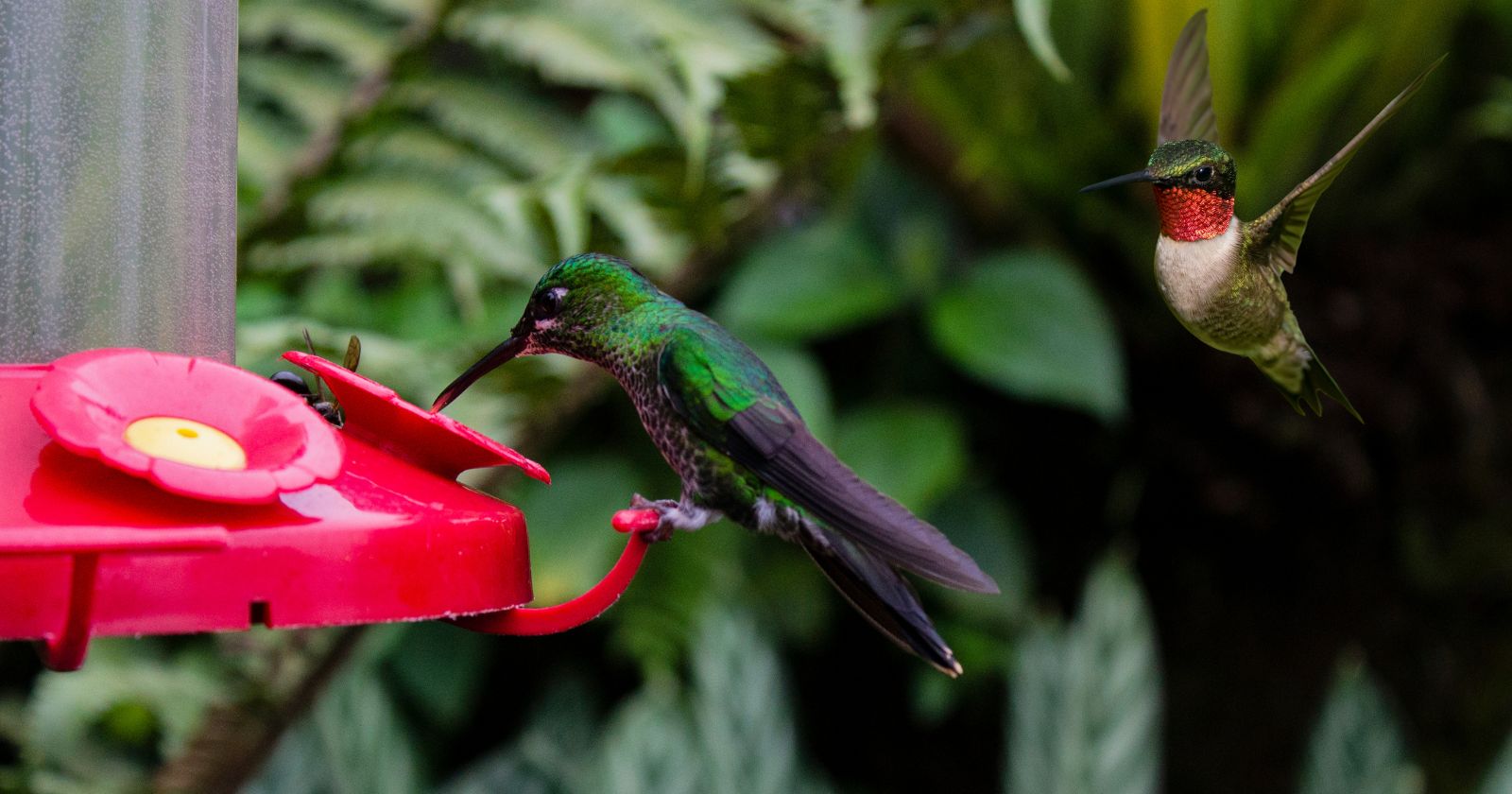Feeding hummingbirds can be a delightful and rewarding experience, but it’s essential to do it correctly to ensure the health and well-being of these tiny birds. Many well-intentioned birdwatchers make mistakes that can harm hummingbirds or discourage them from visiting.
In this blog post, we’ll explore the nine most common mistakes people make when feeding hummingbirds and how to avoid them.
Want to Test Your Knowledge on Feeding Hummingbirds?

What are the most common errors people make when feeding hummingbirds?
The most common errors people make when feeding hummingbirds include using red dye in nectar, neglecting feeder cleanliness, and using incorrect nectar recipes. These mistakes can harm hummingbirds’ health and deter them from visiting your garden.
Now, let’s explore the details of each mistake and learn how to create a safe and inviting environment for these delightful birds.
1. Using Red Dye in Nectar
One of the most widespread and potentially harmful mistakes is adding red food colouring or dye to hummingbird nectar. Many people believe that the red colour attracts hummingbirds, but this is a misconception.
Why it’s a problem:
- Red dye is unnecessary and potentially toxic to hummingbirds
- It can cause health issues, including liver and kidney damage
How to avoid it:
- Use clear nectar in your feeders
- Rely on the red colour of the feeder itself to attract hummingbirds
2. Neglecting Feeder Cleanliness
Failing to clean hummingbird feeders regularly is another common mistake that can have serious consequences.
Why it’s a problem:
- Dirty feeders can harbour harmful bacteria and mould
- Contaminated nectar can make hummingbirds ill
How to avoid it:
- Clean feeders at least once a week, or more often in hot weather
- Use hot water and a mild detergent or a diluted bleach solution
- Rinse thoroughly before refilling
3. Using the Wrong Nectar Recipe
Many people unknowingly use incorrect nectar recipes, which can be detrimental to hummingbirds’ health.
Why it’s a problem:
- Incorrect sugar concentrations can cause dehydration or malnutrition
- Using honey or artificial sweeteners can be harmful to hummingbirds
How to avoid it:
- Use a simple 4:1 ratio of water to white sugar
- Boil the water, add sugar, stir until dissolved, and let cool before filling feeders
- Never use honey, artificial sweeteners, or other types of sugar
4. Improper Feeder Placement
The location of your hummingbird feeder can significantly impact its effectiveness and the birds’ safety.
Why it’s a problem:
- Poorly placed feeders may not attract hummingbirds
- Feeders in direct sunlight can cause nectar to spoil quickly
- Feeders too close to windows can lead to bird collisions
How to avoid it:
- Place feeders 10-15 feet from cover, such as trees or shrubs
- Ensure feeders are visible to birds
- Position feeders in partial shade to keep nectar fresh longer
- Keep feeders away from windows or use window decals to prevent collisions
5. Infrequent Nectar Changes
Leaving nectar in feeders for too long is a common oversight that can be harmful to hummingbirds.
Why it’s a problem:
- Old nectar can ferment or grow mould, making birds sick
- Spoiled nectar may deter hummingbirds from visiting your feeder
How to avoid it:
- Change nectar every 3-5 days, or more frequently in hot weather
- Only fill feeders with as much nectar as the birds can consume in a few days
6. Leaving Empty or Dirty Feeders Out
Many people forget to remove or clean feeders when they’re empty or dirty, which can discourage hummingbirds from returning.
Why it’s a problem:
- Empty feeders waste hummingbirds’ energy as they search for food
- Dirty feeders can harbour harmful bacteria and mould
How to avoid it:
- Regularly check feeders and refill as needed
- Remove and clean feeders if you’ll be away for an extended period
- Consider asking a neighbour to maintain your feeders when you’re away
7. Using Feeders with Yellow Parts
While red attracts hummingbirds, yellow can attract unwanted insects.
Why it’s a problem:
- Yellow parts on feeders can attract bees and wasps
- Insects competing for nectar may deter hummingbirds
How to avoid it:
- Choose feeders without yellow parts
- Opt for feeders with red or clear components
8. Not Providing Natural Food Sources
Relying solely on feeders and neglecting natural food sources is a mistake that limits hummingbirds’ dietary variety.
Why it’s a problem:
- Hummingbirds need a diverse diet for optimal health
- Lack of natural food sources can make birds overly dependent on feeders
How to avoid it:
- Plant nectar-producing flowers in your garden
- Choose native plants that bloom at different times of the year
- Avoid using pesticides that can harm hummingbirds and their insect prey
9. Incorrect Timing of Feeder Placement
Many people put out feeders too late in spring or remove them too early in autumn, missing crucial migration periods.
Why it’s a problem:
- Hummingbirds rely on feeders during migration for energy
- Late placement or early removal can deprive birds of essential food sources
How to avoid it:
- Put feeders out in early spring, about two weeks before the expected arrival of hummingbirds in your area
- Keep feeders up until several weeks after you’ve seen the last hummingbird in autumn
Comparison Table: Common Hummingbird Feeding Mistakes
| Mistake | Potential Consequences | How to Avoid |
|---|---|---|
| Using red dye | Health issues for hummingbirds | Use clear nectar, rely on red feeder colour |
| Neglecting cleanliness | Bacterial growth, illness in birds | Clean feeders weekly with hot water and mild soap |
| Wrong nectar recipe | Malnutrition, dehydration | Use 4:1 water to white sugar ratio |
| Improper placement | Low visitation, spoiled nectar | Place in partial shade, 10-15 feet from cover |
| Infrequent nectar changes | Fermentation, mould growth | Change nectar every 3-5 days |
| Leaving empty/dirty feeders | Wasted energy for birds, discouragement | Regularly check and maintain feeders |
| Yellow feeder parts | Attract bees and wasps | Choose feeders without yellow components |
| No natural food sources | Limited diet for hummingbirds | Plant nectar-producing flowers |
| Incorrect timing | Miss crucial migration periods | Put out feeders early spring, remove late autumn |
Other Post to Read: 33 Top Plants That Attract Hummingbirds.
Final Thoughts
Feeding hummingbirds can be a joyful and rewarding experience when done correctly. By avoiding these common mistakes, you’ll create a safe and welcoming environment that will keep these charming birds coming back to your garden year after year. Remember, the key is to prioritise the health and well-being of the hummingbirds above all else.
Before we conclude, here’s a question for you: What’s your favourite experience or memory involving hummingbirds? We’d love to hear your stories in the comments section below. And if you found this article helpful, please consider sharing it with fellow bird enthusiasts. Thank you for reading and happy hummingbird watching!
Citations:
- https://nationalzoo.si.edu/migratory-birds/hummingbird-nectar-recipe
- https://www.audubon.org/news/hummingbird-feeding-faqs
